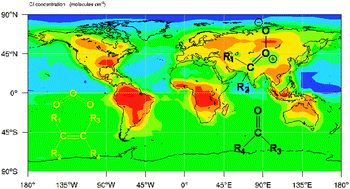Research frontiers in the chemistry of Criegee intermediates and tropospheric ozonolysis
Abstract
The chemistry of carbonyl oxides, known as Criegee intermediates, is central to many aspects of tropospheric chemistry. For decades it has been known that these reactive species, whose electronic structure contains zwitterionic and biradical character, are formed in the ozonolysis of alkenes. However it is only recently that direct measurements of their reaction kinetics have become possible. In this perspective we describe the most recent progress in understanding the reactivity of these historically elusive molecules, explore the atmospheric chemistry implications of new experimental discoveries, and propose important new areas for investigation.


 Please wait while we load your content...
Please wait while we load your content...